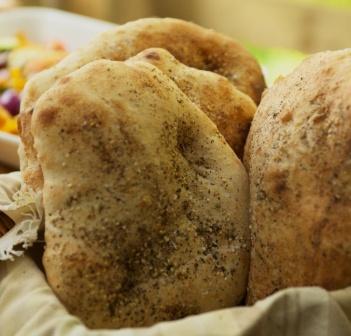Bread Making Course
Can I make Bread?
Without a doubt the answer to this is ‘yes’! Bread is really a very simple thing to make and I can guarantee that once you’ve baked two or three successful loaves you’ll be hooked on the whole process.
Here’s how to make bread:
- Mix flour, water, salt and yeast. (Yes, that’s all you need)
- Stretch it a bit to make it stronger (Kneading bread is a mini workout and quite relaxing)
- Leave it to ferment to develop flavour and texture (Take a break after all that hard work)
- Shape it (Into any of a million shapes, a chance to be creative)
- Leave it to become light and airy (Take a break after all that hard work)
- Bake it (The oven does this bit. You just put it in, leave it and take it out again)
So none of that sounds too taxing. Of course it can get a little more technical if you want to make an 8 strand plait, create huge holes, bake a chewy crust, or a soft crust, bake 200 loaves a day or vary your bread in any of an infinite number of ways; but the basics steps never really change.
So why don’t we all bake our own bread? …. mostly due to the misconceptions routinely attached to baking:
- It requires heaps of very specific knowledge and skills. (See above)
- Handling dough is really tricky. (It is true that handling some dough well requires a bit of practice, but doing anything well requires a bit of practice)
- It requires the temperature to be just right. (Bread is popular in Africa and Alaska and bakers there manage to bake some fantastic bread)
- Yeast is very temperamental. (Maybe it was once when it was harvested from the top of beer vats but modern yeast isn’t)
- It takes ages. (Overall it usually takes a few hours but mostly that’s fermenting, rising and baking time, hands on time is just a few minutes)
- My hands are too cold (Unless you have a circulatory condition or are suffering from hypothermia your hands are the same temperature as everyone else give or take a few points of 1 degree)
- It won’t be as good as the bread I buy. (If you buy industrial supermarket bread this is not true. If you buy bread from a experienced artisan bakery this will be true for the first few months of making your own, then your bread will be as good as theirs and you’ll have the satisfaction of having made it yourself and it will be cheaper)
So come on, enough with the excuses. Get a bag of flour, a bit of yeast and get baking!
Make Some Easy Bread:
The easiest bread to make is a simple flat bread. They’ve been making bread like this for thousands of years all around the Mediterranean and still do so today so it can’t be bad. It’s great dipped in olive oil, with soup, or as an accompaniment to any meal.
To start we’ll make a basic dough. You’ll need:
- 250g white bread flour. (Make sure it’s called bread flour or strong flour)
- ½ tsp instant yeast
- ½ tsp salt
- 160g/160ml water (it’s easier to weigh water if you have a digital scales.
- Olive Oil
- Dried herbs
- Sesame Seeds
- A little salt
- Mix all the ingredients and knead the dough. (see the video below where you’ll see how to knead)
- Put the dough in an, oiled, covered bowl and leave the dough to ferment in your kitchen for 1 ½ hours. (You are now employing a workforce of millions of yeast spores to work for you in return for food and a comfortable environment; be proud)
- Flour a patch of work surface and carefully turn the dough out onto it.
- Using eight fingers at a time push down into the dough all over. You’ll see the dough spread. Using this technique is simpler and gives a more bubbly texture to your bread than rolling. I call it ‘dibbling the dough’.
- Keep dibbling the dough until it is about 1cm thick all over. Flour beneath it now again to make sure it doesn’t stick to the table. If you’ve dibbled evenly the dough will be roughly circular but no ones really going to care if it isn’t. You may find it easier to dibble a bit then leave the dough for a couple of minutes. This allows the dough to relax making it easier to work.
- Place the dough on a baking sheet and cover with a clean cloth. Leave for 20 minutes.
- Turn the oven on and set to 230°C/gas mark 8.
- After 20 minutes, drizzle a little olive oil on top of the dough, about two tablespoons should do it. Lightly dibble once more.
- Sprinkle the top with dried herbs, sesame seeds and a little salt if you like. Pop it straight into the oven.
- Bake for 10-12 minutes until the edges of the dough are nicely browned.
- Allow to cool on a rack.

